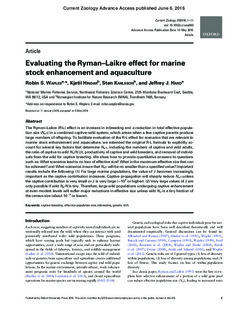Evaluating the Ryman–Laikre effect for marine stock enhancement and aquaculture
Journal article, Peer reviewed
Permanent lenke
http://hdl.handle.net/11250/2425095Utgivelsesdato
2016Metadata
Vis full innførselSamlinger
- Publikasjoner fra CRIStin - NINA [2364]
- Scientific publications [1392]
Sammendrag
The Ryman–Laikre (R-L) effect is an increase in inbreeding and a reduction in total effective population
size (NeT) in a combined captive–wild system, which arises when a few captive parents produce
large numbers of offspring. To facilitate evaluation of the R-L effect for scenarios that are relevant to
marine stock enhancement and aquaculture, we extended the original R-L formula to explicitly account
for several key factors that determine NeT, including the numbers of captive and wild adults,
the ratio of captive to wild Ne/N (b), productivity of captive and wild breeders, and removal of individuals
from the wild for captive breeding. We show how to provide quantitative answers to questions
such as: What scenarios lead to no loss of effective size? What is the maximum effective size that can
be achieved? and What scenarios insure that NeT will be no smaller than a specified value? Important
results include the following: (1) For large marine populations, the value of b becomes increasingly
important as the captive contribution increases. Captive propagation will sharply reduce NeT unless
the captive contribution is very small or b is very large ( 103 or higher). (2) Very large values of b are
only possible if wild Ne/N is tiny. Therefore, large wild populations undergoing captive enhancement
at even modest levels will suffer major reductions in effective size unless wild Ne is a tiny fraction of
the census size (about 10 4 or lower).

